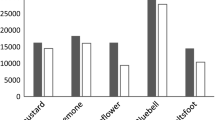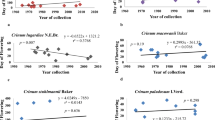Abstract
Drought-adapted geophytes are responding to the effects of climate change in arid and semi-arid environments. In this study, herbarium and historical rainfall data were used to examine the impact of rainfall changes on flowering trends of Pancratium tenuifolium Hochst. ex A.Rich and Scadoxus multiflorus (Martyn) Raf. subsp. multiflorus. Flowering was delayed by approximately 7 days per decade for P. tenuifolium during the period 1930 to 2018 and by approximately 14 days per decade for S. multiflorus subsp. multiflorus during the period 1924 to 2008. Scadoxus multiflorus subsp. multiflorus delayed the day of flowering by approximately 0.3 days per millimetre increase of rainfall, with Pancratium tenuifolium showing a non-significant response to summer rainfall during the same period. Overall, a linear mixed-effects model revealed that the day of flowering was delayed by approximately 8 days per degree rise in latitude and advanced by approximately 9 days per degree rise in longitude. Additionally, summer rainfall had significant effects on the day of flowering with a 1-mm increase in summer rainfall delaying the day of flowering by approximately 0.16 days. These changes in flowering times may ultimately alter the distribution of geophytes in Namibia.



Similar content being viewed by others
Data availability
The herbarium data associated with this publication are deposited at the National Herbarium of Namibia.
References
Abu-Asab MS, Peterson PM, Shetler SG, Orli SS (2001) Earlier plant flowering in spring as a response to global warming in the Washington, DC, area. Biodivers Conserv 10:597–612
Anderson MK (1997) From tillage to table: the indigenous cultivation of geophytes for food in California. J Ethnobiol 17(2):149–169
Beatley JC (1974) Phenological events and their environmental triggers in Mojave Desert ecosystems. Ecology 55:856–863
Bjorkman AD, Vellend M, Frei ER, Henry GHR (2017) Climate adaptation is not enough: warming does not facilitate success of southern tundra plant populations in the high Arctic. Glob Chang Biol 23:1540–1551
Bock A, Sparks TH, Estrella N, Jee N, Casebow A, Leuchner M, Menzel A (2015) Climate sensitivity and variation in first flowering of 26 Narcissus cultivars. Int J Biometeorol 59:477–480
Calinger, KM (2014) Investigating the footprint of climate change on phenology and ecological interactions in north-central North America. Teaching Issues and Experiments in Ecology - Volume 10 - volume 10, April 2014. pp. 1–29
Calinger KM, Queenborough S, Curtis PS (2013) Herbarium specimens reveal the footprint of climate change on flowering trends across north-central North America. Ecol Lett 16:1037–1044
Crimmins TM, Crimmins MA, Bertelsen CD (2011) Onset of summer flowering in a ‘Sky Island’ is driven by monsoon moisture. New Phytol 191:468–479
Cronbach LJ, Gleser GC, Nanda H, Rajaratnam N (1972) The dependability of behavioral measurements: theory of generalizability for scores and profiles. Wiley, New York
De Vynck JC, Van Wyk BE, Cowling RM (2016) Indigenous edible plant use by contemporary Khoe-San descendants of South Africa’s Cape South Coast. S Afr J Bot 102:60–69
Demissew S, Nordal I, Stabbetorp OE (2003) Flowers of Ethiopia and Eritrea: aloes and other lilies. Shama’s Nature Series, Addis Ababa
Dirkx E, Hager C, Tadross M, Bethune S, Curtis B (2008) Climate change vulnerability and adaptation assessment Namibia. Desert Research Foundation Namibia and Climate Systems Analysis Group. UCT, Windhoek, pp 149–149
Duncan G (2001) Spectacular, Rewarding Scadoxus. Veld Flora 87(1):60–63
Haggerty BP, Hove AA, Mazer SJ (2012) Skeletons in the closet: preserved plants reveal phenological responses to climate change. Guide and practice data set for college and public audiences for analyzing long-term phenological data. Available online at the California Phenology Project website www.usanpn.org/cpp/education
IPCC (2014) Climate change 2014: synthesis report. Contribution of Working Groups I, II and III to the Fifth Assessment Report of the Intergovernmental Panel on Climate Change [Core Writing Team, R.K. Pachauri and L.A. Meyer (eds.)]. IPCC, Geneva, Switzerland, 151 pp
Jarvis A, Lane A, Hijmans RJ (2008) The effect of climate change on crop wild relatives. Agric Ecosyst Environ 126(1):13–23
Kalbarczyk R (2009) The effects of climate change in Poland on the phenological phases of onion (Allium cepa L.) between 1966 and 2005. Agric Conspec Sci 74(4):297–303
Kwembeya EG, Pazvakawambwa L (2019) The changing flowering phenology of Crinum lilies in arid and semi-arid regions: implications for phenological responses to climate change. Biologia. 74:1465–1474. https://doi.org/10.2478/s11756-019-00329-5
Lambert AM, Miller-Rushing AJ, Inouye DW (2010) Changes in snowmelt date and summer precipitation affect the flowering phenology of Erythronium grandiflorum (glacier lily; Liliaceae). Am J Bot 97:1431–1437
Llorens L, Peñuelas J (2005) Experimental evidence of future drier and warmer conditions affecting flowering of two co-occurring Mediterranean shrubs. Int J Plant Sci 166(2):235–245
Manning J, Smith D (2017) Night hawk: pollination of Pancratium tenuifolium. Veld Flora 103(4) December:168–170
Marcoulides GA (1993) Maximizing power in generalizability studies under budget constraints. J Educ Stat 18(2):197–206
Matsuoka Y, Takumi S, Kawahara T (2008) Flowering time diversification and dispersal in central Eurasian wild wheat, Aegilops tauschii Coss.: genealogical and ecological framework. PLoS One 3(9):1–9
Matthews ER, Mazer SJ (2015) Historical changes in flowering phenology are governed by temperature x precipitation interactions in a widespread perennial herb in western North America. New Phytol 210:157–167
Mendelsohn J, Jarvis A, Roberts C, Robertson T (2002) Atlas of Namibia. A portrait of the land and its people. David Philip Publishers, Cape Town
Menzel AT, Sparks H, Estrella N, Roy DB (2006a) Altered geographic and temporal variability in phenology in response to climate change. Glob Ecol Biogeogr 15:498–504
Menzel A, Sparks TH, Estrella N, Koch E, Aasa A, Ahas R, Alm-Kübler K, Bissolli P, Braslavska O, Briede A, Chmielewski FM, Crepinsek Z, Curnel Y, Dahl Å, Defila C, Donnelly A, Filella Y, Jatczak K, Mage F, Mestre A, Nordli Ø, Peñuelas J, Pirinen P, Remišova V, Scheifinger H, Striz M, Susnik A, Van Vliet AJH, Wielgolaski F, Zach S, Zust A (2006b) European phenological response to climate change matches the warming pattern. Glob Chang Biol 12:1969–1976
Miller-Rushing AJ, Primack D, Primack RB, Mukunda S (2006) Photographs and herbarium specimens as tools to document phenological changes in response to global warming. Am J Bot 93:1667–1674
Molnár AV, Tökölyi J, Végvári Z, Sramkó G, Sulyok J, Barta Z (2012) Pollination mode predicts phenological response to climate change in terrestrial orchids: a case study from entral Europe. J Ecol 100:1141–1152
Munson SM, Sher AA (2015) Long-term shifts in the phenology of rare and endemic Rocky Mountain plants. Am J Bot 102(8):1268–1276
Nordal I, Duncan T (1984) A cladistics analysis of Haemanthus and Scadoxus. Nord J Bot 4:145–153
Nordal I, Demissew S, Stabbertorp OE (2001) Endemism in groups of Ethiopian geophytes (“Liliiflorae”). Biol Skr 54:247–258
Panchen ZA, Primack RB, Anisko T, Lyons RE (2012) Herbarium specimens, photographs, and field observations show Philadelphia area plants are responding to climate change. Am J Bot 99:751–756
Pearson KD (2019) Spring- and fall-flowering species show diverging phenological responses to climate in the Southeast USA. Int J Biometeorol 63:481–492
Piao S, Friedlingstein P, Ciais P, Viovy N, Demarty J (2007) Growing season extension and its impact on terrestrial carbon cycle in the Northern Hemisphere over the past 2 decades. Glob Biogeochem Cycles 21:GB3018. https://doi.org/10.1029/2006GB002888
Proches S, Cowling RM, Goldblatt P, Manning JC, Snijman DA (2006) An overview of the Cape geophytes. Biol J Linn Soc 87:27–43
Ranjitkar S (2013) Effect of elevation and latitude on spring phenology of rhododendron at Kanchenjunga conservation area, east Nepal. Int J Appl Sci Biotechnol 1(4):253–257
Rathcke B, Lacey EP (1985) Phenological patterns of terrestrial plants. Annu Rev Ecol Syst 16:179–214
Raunkiær C (1905) Types biologiques pour la géographie botanique. Oversigt over Det Kongelige Danske Videnskabernes Selskabs Forhandlinger 1905:347–438
Redden R, Yadav SS, Maxted N, Dulloo ME, Guarino L, Smith P (2015) Crop wild relatives and climate change. John Wiley & Sons Inc. New Jersy, Hoboken
Saikkonen K, Taulavuori K, Hyvonen T, Gundel PE, Hamilton CE, Vänninen I, Nissinen A, Helander M (2012) Climate change-driven species’ range shifts filtered by photoperiodism. Nat Clim Change 2:239–242
Shapiro SS, Wilk MB (1965) An analysis of variance test for normality. Biometrika 52:591–611
Von Holle B, Wei Y, Nickerson D (2010) Climatic variability leads to later seasonal flowering of Floridian plants. PLoS One 5:e11500
Von Koenen E (2001) Medicinal, poisonous and edible plants in Namibia. Edition Namibia Vol. 4. Klaus Hess Publishers. Namibia
Went F (1949) Ecology of desert plants. II. The effect of rain and temperature on germination and growth. Ecology 30:1–13
Youngblood D (2004) Identification and quantification of edible plant foods in the upper (Nama) Karoo, South Africa. Econ Bot 58(Supplement):S43–S65
Zimudzi C, Archer R, Kwembeya EG, Nordal I (2008) Amaryllidaceae. In: Timberlake J (ed) Flora Zambesiaca Vol 13(2). Royal Bot, Gardens Kew, pp 97–134
Acknowledgments
I thank the authorities of the National Botanical Research Institute of Namibia (NBRI) and the Meteorological Services of Namibia for providing herbarium and rainfall data respectively. Mr. D. Aiyambo and Ms. Vanessa Stein from NBRI are acknowledged for helping with data extraction and mapping of the species, respectively. Dr. Timothy Sibanda is thanked for his valuable comments during the study.
Author information
Authors and Affiliations
Corresponding author
Ethics declarations
Conflict of interest
The author declares that he has no conflict of interest.
Appendix
Appendix
Rights and permissions
About this article
Cite this article
Kwembeya, E.G. Tracking biological footprints of climate change using flowering phenology of the geophytes: Pancratium tenuifolium and Scadoxus multiflorus. Int J Biometeorol 65, 577–586 (2021). https://doi.org/10.1007/s00484-020-02052-2
Received:
Revised:
Accepted:
Published:
Issue Date:
DOI: https://doi.org/10.1007/s00484-020-02052-2




